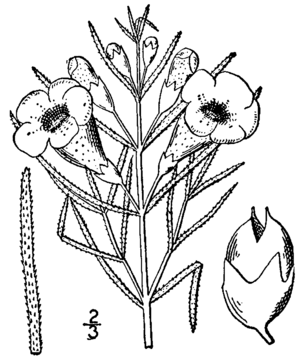Rough agalinis facts for kids
Quick facts for kids Rough agalinis |
|
|---|---|
 |
|
| Scientific classification | |
| Genus: |
Agalinis
|
| Species: |
aspera
|
The rough agalinis (also known as rough false foxglove or tall false foxglove) is a special plant. Its scientific name is Agalinis aspera. This plant is not poisonous. It grows naturally in dry, grassy areas called prairies. The rough agalinis can grow to be about 8 to 24 inches tall. When its flowers bloom, they are usually purple or pink.
Contents
Where Does the Rough Agalinis Grow?
This plant grows naturally in parts of the United States and Canada. You can find it in states like Arkansas, Iowa, Illinois, Kansas, Minnesota, Missouri, North Dakota, Nebraska, Oklahoma, South Dakota, Texas, and Wisconsin. It also grows in Manitoba, Canada.
The rough agalinis needs certain places to grow. It likes to bloom in low, wet meadows. It can also be found along hillsides. This plant blooms from June to September.
What Family Does It Belong To?
The rough agalinis is part of the plant family called Orobanchaceae. Scientists used to think it was in a different family. They changed its family after studying its genes very closely.
Why Is It Called That?
The name Agalinis comes from a Latin word. It means "remarkable flax." The word aspera also comes from Latin. It means "rough" or "harsh." This name describes the rough feel of the plant's leaves.
Why Is It Endangered?
The rough agalinis is considered an endangered plant. This means there are not many of them left. One reason for this is where the plant grows. When it grows in low, wet areas, these places can sometimes dry out. This causes the plants to disappear.
Human activities also threaten these plants. Many rough agalinis plants grow near roads. If roads are made wider or straighter, these plants are at risk. Any big changes to these areas can harm the plant populations.

